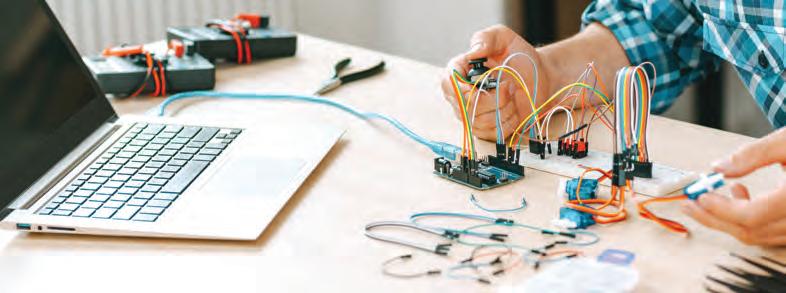
3 minute read
Do we really need to prototype?
A hardware vs software design perspective
BY PHILIP LING, EDITOR, SENIOR TECHNICAL WRITER, AVNET
We live in the age of over-the-air updates and constant upgrades. These can be used to fix bugs, but they are also used to deliver value-added or paid-for features. Products are now designed to change after shipping, so does that make the concept of prototyping redundant?
The word ‘prototype’ is widely understood to mean the first of its type. As such, it represents the form, fit and function of the final product. For all intents and purposes, it is the finished product in every way that matters. But, design teams must also accept that building a prototype could force design changes. Otherwise, is there really any value in building a prototype? And, with the widespread practice of using over-the-air (OTA) updates to change functionality, can a prototype really be referred to as the first of its type?
Here, we present both sides of the argument, from the perspectives of two engineers. One comes from a hardware background and the other from the software domain.
Hardware engineer says...
Practically anything can be prototyped. Sometimes, making a prototype is the only way to realize the vision. Importantly, it can uncover the unforeseen issues involved with both design and manufacturing. Because it uncovers valuable information, prototyping your design – particularly a complex part –becomes integral to the development process.
Software engineer says...
Physical prototyping was arguably more important when design was a human-centric process. A design would emerge organically, rather than be defined algorithmically. Early design required physical models by necessity. Modern computing may make physical modelling redundant. Aesthetically, a virtual model can be rendered with enough detail that it appears real.
Hardware engineer says...
Of course, modeling is useful but the more we ask from our models the more data they produce. Processing that data becomes more difficult, requiring more processing power to do something useful with the data. Every design iteration, no matter how small, might require the entire design to be remodeled, again and again. That’s a lot of data and a lot of processing power. A physical model is simpler to manipulate and refine.
Software engineer says...
We live in the age of hyperscale computing. Processing power is cheap and plentiful. Yes, modelling generates a lot of data that needs to be processed, and that can take a lot of effort. But, the next logical step is to use artificial intelligence to infer results from the data. This would remove the need to process all the actual data. Physical design is becoming increasingly intractable. At some point, using AI could be the only way to achieve meaningful results. We can’t ignore the fact that most things can now be modelled with enough accuracy to make a physical prototype unnecessary. Computer modelling is getting faster and less expensive. Add to this the features of virtual and augmented reality and things really come alive. Do we still need physical prototypes?
Hardware engineer says...
It’s true that technology helps in many ways. Engineers are using additive manufacturing techniques such as 3D printing to make physical prototypes faster than ever, which blurs the line between real and virtual. The design files used for the model can also be used in production and conventional manufacturing processes. So perhaps the real value of virtual prototyping is to get it into the real world.
Software engineer says...
Why bring a model into the real world at all? The crucial point is that a computer design is pure data. Anything done to a computer model will be captured as data. Compare this to building a physical prototype and then capturing the data when it is dropped, submerged, heated or cooled. Once, twice or 10 times might be easy, but what about 10,000 times or more?
From concept to production
Embedded systems are becoming more general purpose. They typically feature predictable building blocks, such as power, storage and processing. These common features don’t need to be (re)designed for every product. The use of single-board computers supports this argument. Are they the only physical prototype we need?
Hardware engineer says...
Embedded systems are all similar, but they are also all different. Admittedly, developments in firmware over-the-air updates and partial reconfiguration of FPGAs could be used to accelerate product development. But it would be difficult and costly to standardize on a common, configurable hardware platform. It would also rely on being able to design a product after it goes into the production phase.
Software engineer says...
Agile processes have all but replaced the waterfall model for software development because it works better. The same could happen in embedded systems by using pre-designed blocks. There are only so many ways you can put hardware components together, the real design is in the software.
Hardware engineer says...
Tell that to car makers. Concept cars presented at shows rarely make it into production and the vehicle is unlikely to even function. They still go to the expense of creating the concept, physically, because they know the value in having something real to look at, to touch, to experience. An auto maker wouldn’t dream of going direct from concept to production without many stages in between.
Software engineer says..
The automotive market is one of the biggest uses of over-the-air updates. Many of the semi vendors provide sector-qualified integrated products support OTA for car OEMs. In the future, the real driver experience will come from software upgrades.
Philip Ling is editor-in-chief & senior technical writer at Avnet. He has more than 30 years of industry experience, including working as a design engineer on mixed-signal embedded systems.







